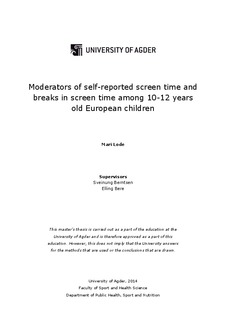| dc.description.abstract | Introduction: To date it is unknown whether there are moderating variables for the associations between children’s self-reported screen time and breaks in screen time and objectively measured sedentary time and breaks in sedentary time. The aim of the present study was to examine whether the associations between self-reported screen time and breaks in screen time and accelerometer assessed sedentary time and breaks in sedentary time were moderated by gender, ethnicity, children’s moderate-to vigorous physical activity (MVPA), parents’ educational level, parents’ screen time and breaks in screen time and parents physical activity (PA).
Methods: Screen time and breaks in screen time were assessed with questionnaires in a sample of 445 children (10-12 years) in Belgium, Greece, Hungary and Norway. Parents’ screen time, breaks in screen time, parents’ PA and demographics were also assessed with questionnaires. Accelerometers measured sedentary time per day and breaks in sedentary time per day and MVPA (children only). Bivariate and multivariate linear regression analyses were applied to assess the associations between the independent variables and the dependent variables. Interaction terms were added in the final model to examine whether the associations between self-reported screen time and breaks in screen time and accelerometer assessed sedentary time and breaks in sedentary time were moderated by the significant independent variables.
Results: No statistical significant interactions were found between the significant independent variables. Country specific significant associations were found between self-reported screen time and gender, parents’ screen time, parents’ educational level and accelerometer assessed sedentary time. Country specific associations were found between self-reported breaks during one hour of screen time and parents’ educational level and ethnicity.
Conclusion: The associations between self-reported screen time and breaks in screen time and accelerometer assessed sedentary time and breaks were not moderated by gender, ethnicity, MVPA, parents’ educational level, parents’ self-reported screen time and breaks in screen time and parents’ PA.
Keywords: children, sedentary behavior, screen time, breaks, questionnaire, accelerometer, measurement. | nb_NO |
